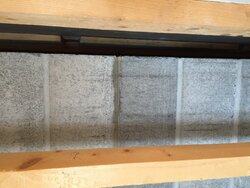I'm building a house and last fall we had a tile lined brick and block chimney built. It wasn't used at all last year, and we got our woodstock keystone up and running 2 months ago. We were hanging sheetrock upstairs today, and my wife noticed one of the mortar joints looked different from the rest. This looks to me like we have a bad time joint and its leaking smoke into the area around the flue. How concerned should I be, and what would the solution be on what is a really new chimney?



